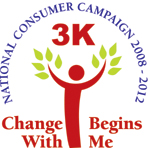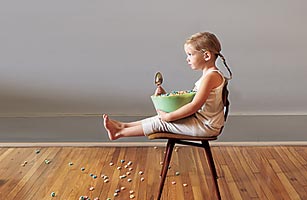| Sweet Spot: How Sugary Cereal Makers Target Kids |
 |
 |
 |
| Written by 3K Admin |
| Monday, 26 October 2009 18:29 |
|
By Bonnie Rochman Monday, Nov. 02, 2009 Before food politics became a Wikipedia entry and the title of a book, before anyone cared about trans fat or realized we were in the midst of a pediatric-obesity epidemic, Lucky Charms were simply magically delicious. Now the cereal, along with other childhood favorites like Corn Pops and Cocoa Pebbles, is being labeled a public-health menace by Yale's Rudd Center for Food Policy and Obesity. The center is trying to expose the marketing tactics that make kids clamor for a sugary start to the day, crispy calorie bombs that are often low in fiber and high in junky carbohydrates. Rudd researchers just finished crunching Nielsen and comScore data — which track television and Internet marketing — to figure out exactly how much cereal advertising kids see. The result: obesity researchers for the first time have hard data proving that the least healthy cereals are the ones marketed most aggressively to children. On Friday the SMART CHOICES program announced it would postpone operations after the commissioner of the U.S. Food and Drug Administration said the agency plans to develop standardized criteria to guide future packaging proclamations. Smart choice or not, sugary cereals clearly hold sway over millions of children. The Rudd findings, which will be detailed at CerealFacts.org in time for the Obesity Society's annual meeting in Washington on Oct. 26, show that each year preschoolers (ages 2 to 5) see an average of 507 cereal ads that are designed to appeal to kids. The report also details how sugary-cereal makers are interacting with young consumers online through video games like Lucky Charms Charmed Life and Cinnamon Toast Crunch Swirl. With more than 20 games, General Mills' popular Millsberry.com gets more than 750,000 unique visitors a month under age 18; the average youngster who uses the site visits 2.8 times a month and spends nearly 24 min. per session. About a third of children in the U.S. are considered overweight or obese, and researchers believe television advertising is a significant contributing factor. A study in the July issue of Health Psychology showed that 7-to-11-year-old kids who watched a cartoon peppered with food commercials ate 45% more snacks while viewing the show than did kids who watched the same program without ads. In the U.S., there are few restrictions on food ads, but that's not the case in the U.K., where junk food can't be marketed on children's television. "There is only one [children's] cereal brand in the U.S. that would be allowed to be advertised on TV in the U.K., and that's Frosted Mini-Wheats because of the amount of fiber," says Jennifer Harris, who spearheaded the Rudd research. Cereal makers have responded to the obesity crisis by reducing calories, fat and sugar and boosting fiber and vitamins. Twelve of some of the country's largest food players — including Kellogg, General Mills and Quaker's parent company, PepsiCo — have promised to market only "better for you" foods to kids under 12. Of course, companies decide what counts as "better for you," ensuring that their products meet the standards. "I wouldn't say there isn't still room for improvement," says Elaine Kolish, director of the industry's Children's Food and Beverage Advertising Initiative. "Could the sugar be less? Yes, but it's better to be 12 grams instead of 13 or 14 or 15, and that's what the companies have moved away from." They may need to do more of that kind of moving. On Oct. 15, Richard Blumenthal, Connecticut's attorney general, announced that he is launching an investigation into whether the smart choices label violates his state's consumer-protection laws. "What's so 'smart' about Froot Loops?" he asked at a press conference. If the label is found to be misleading, it will need to be changed, he said. A spokeswoman for General Mills said the company declined to comment for this story, but Kellogg CEO David Mackay defends his firm's much maligned Froot Loops, noting that the cereal is a good source of vitamins A and C. And those 12 g of sugar? "Twelve grams of sugar is 50 calories," says Mackay. "A presweetened cereal as part of a regular diet for kids is not a bad thing." But it's hard to argue that it's a good thing either. The original version of this story has been updated to incorporate information from an announcement by SMART CHOICES on Friday, Oct. 23. |
| Last Updated on Monday, 26 October 2009 18:32 |


